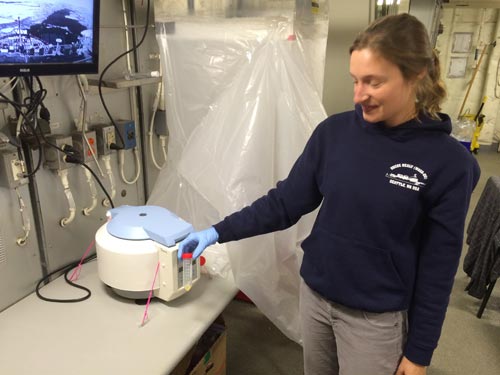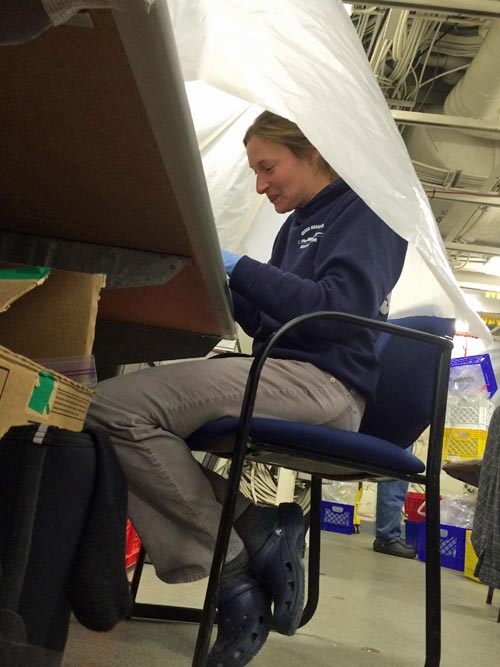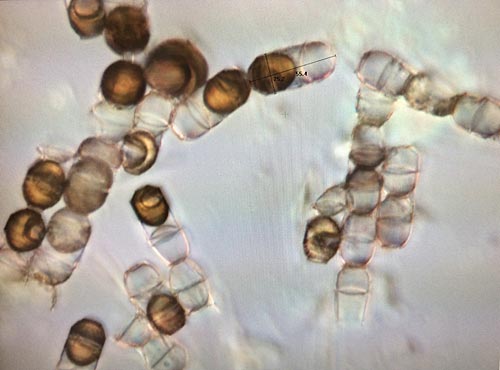Cruise Day 37
Speed 6 knots (kts) Course 204° (SSW) Location Alpha Ridge, ~258 nautical miles south of N. Pole Depth 2703 m
GO DEEPER DISCUSSION: (see previous journal for the questions.)
Check my math to see if you agree with the answer to yesterday’s Go Deeper!
The formula for the volume of a sphere is 4/3 π r^3. However, the measurements I provided were of the circumference of our Styrofoam head, which we were approximating to be spherical. We can get the radius from the circumference pretty easily:
Circumference = 2π r, so: r = circumference / 2π
This gives the un-shrunken head a radius of 8.51cm and the small head a radius of 4.84 cm.
Plugging those into our sphere volume formula, we get: Un-shrunken Head Volume ~ 2581.5 cubic centimeters Shrunken Head Volume ~ 474.9 cubic centimeters.
If we divide 2581.5 by 474.9, we see that the shrunken head is about 5.44 times smaller in volume than the original un-shrunken head.
TODAY’S JOURNAL:
After yesterday’s sunny and cold run through some beautiful ice, we reached our next ice station. Unfortunately, just when we were about ready to deploy after dinner, conditions rapidly changed as fog enveloped us. Since the polar bear watch on the bridge wants ~2-mile visibility, the station was put on hold. We waited all night (by the clock – remember, the sun still hasn’t set on us up this far north for weeks), and just after breakfast it cleared up enough to drop the brow, have the ice rescue team confirm safe ice conditions, and head out for the ice station. I spent most of the day checking up on different sampling teams and helping out with some of the work. Near the end of the station’s planned duration, visibility was closing in with snow and fog cloaking us, and we had to pack it up about an hour early. Most samples had been collected but hopefully at our next full station nobody will have to pack it in before they are completely ready. Now we’ve just headed off again south towards the next stop at our second “super station.”
Many more ice cores came aboard, which is a good segue into another aspect of the ice being studied: Microscopic life in the ice itself. A few days ago I caught up with Sara Rauschenberg, Research Associate at Bigelow Lab, Maine. Sara is involved with many scientific aspects of the cruise, but a particularly interesting one involves taking ice from the lower part of the core (where it interfaces with sea water) and melting it. This water is placed in centrifuge tubes that have two tiny discs with microscopic grids etched on them placed on the bottom of the tube. (Prior to placing the grids, the conical part of the tube is leveled with a polymer to give it a nice flat surface at the bottom to work with.) When the tubes are given a jolly good spin in the centrifuge, cells in the melted ice water are forced to the bottom of the tube, and some stick to the tiny grids. Sara carefully preserves the sample, drains the water, cuts the tube off to get access to the little gridded discs, and mounts them on a special slide for microscopic analysis.
 Sara Rauschenberg with centrifuge and sample tube for concentrating cells.
Sara Rauschenberg with centrifuge and sample tube for concentrating cells.
 Sara Rauschenberg works with her cellular samples in a clean area with HEPA-filtered air blown down and out of the plastic mini-bubble at her lab bench.
Sara Rauschenberg works with her cellular samples in a clean area with HEPA-filtered air blown down and out of the plastic mini-bubble at her lab bench.
 Mounted sample grids are collected from the centrifuge tubes for microscopic analysis and later synchrotron studies.
Mounted sample grids are collected from the centrifuge tubes for microscopic analysis and later synchrotron studies.
Under a beautifully precise microscope, Sara finds cells and can determine things like the density and types of microscopic life living in the ice. But the really cool thing that Sara does on board is to carefully map out the exact position of cells on each grid. Once the specimens get back to a lab on shore, the samples are analyzed in a wickedly powerful instrument called a synchrotron that can map out the exact position of trace elements within each cell based on the precise positions that Sara mapped. So she’s not just seeing if a certain single-celled organism is using something like nickel in a cellular process, but precisely where in the cell the nickel is being used.
 Sara demonstrates her microscope’s capabilities by showing me cells from the ropy diatom, Melosira arctica, that I wrote about a couple of days ago (Life Under Ice, Sept. 12.)
Sara demonstrates her microscope’s capabilities by showing me cells from the ropy diatom, Melosira arctica, that I wrote about a couple of days ago (Life Under Ice, Sept. 12.)
 This diatom has capsule-shaped cell walls (also called tests) made of silica, which is essentially glass. The brownish part is the living cell inside the test. Note also empty tests left behind when a diatom cell dies. These tests are about 55 microns (millionths of a meter) long and about 25 microns wide. Photo courtesy of Sara Rauschenberg.
This diatom has capsule-shaped cell walls (also called tests) made of silica, which is essentially glass. The brownish part is the living cell inside the test. Note also empty tests left behind when a diatom cell dies. These tests are about 55 microns (millionths of a meter) long and about 25 microns wide. Photo courtesy of Sara Rauschenberg.
Finding out about things like this reminds me why I like science so much, and is another example of the incredible opportunity to learn new stuff every day on the cruise!
GO DEEPER!
I missed out on the Sunday riddle yesterday, giving you a math problem instead. To make up for that, here’s a Monday riddle:
H, I, J, K, L, M, N, O
Aloft Con web cam updated every hour
Healy Track
That's all for now. Best- Bill

